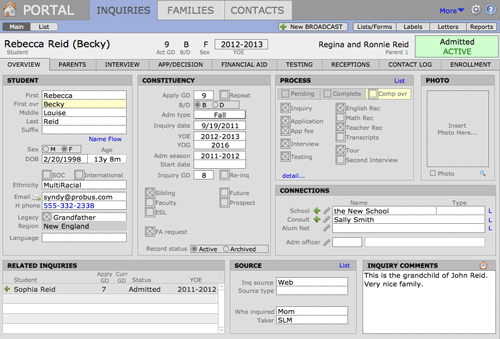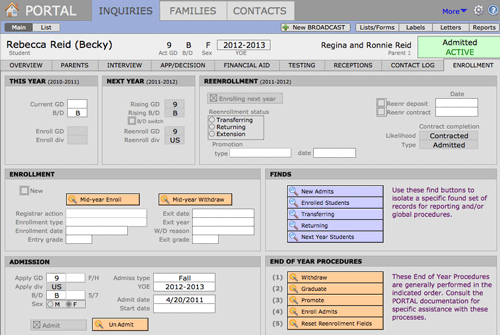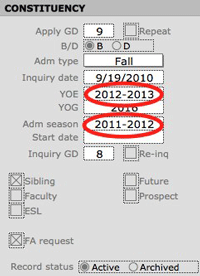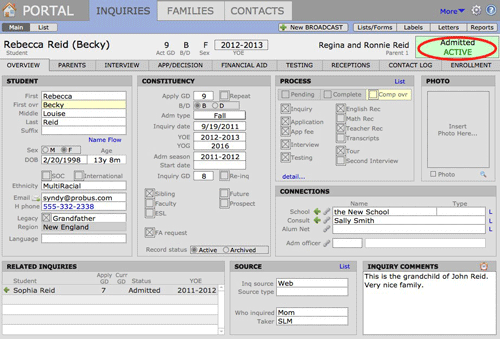PORTAL manages the entire admissions process in addition to tracking enrollment and re-enrollment. PORTAL is designed this way because the Office of Admission needs to know the number of spaces available at any given time in order to admit candidates to fill those spaces. In this documentation, we refer to processes as either being part of the Admission Realm or the Enrollment Realm.
Because PORTAL reporting mixes admission and enrollment data, there are many more records in the INQUIRIES table than simply the current season’s inquiries. Other records are kept in the table for numerous uses, such as producing year-on-year statistics and being available to search for children who inquire again. Still other kinds of records that are tracked are those where the Admission Office has contacted potential candidates or where a family has contacted the school for possible enrollment for some future year.
The Admission Realm
The Admission Realm includes all the activities from the initiation of contact with the school by a child or family (or the school contact with a child or family) until the admission of that child and the offering of that child to the Registrar for matriculation. The process starts with an inquiry and, if successful, ends when the child is admitted. Many of the inquiries are not successful, of course, for a variety of reasons. These are all tracked in PORTAL in order to report detailed statistics over time. All these Admission Realm activities are principally managed on the main screens in the INQUIRIES file—Overview, Parents, Interview, App/Decision, Financial Aid, Testing, Receptions, and Contact Log.

The Enrollment Realm
The Enrollment Realm of PORTAL mirrors the actions that are usually done by a school Registrar. At some multi-division schools there isn’t a Registrar and the Office of Admission may be the only place where complete school numbers can be found. Enrollment tasks, such as contracting and forms collection, are better done here than at the Registrar or Business Office because the Office of Admission alone possesses records of all the needed children—those new to the school and those returning. The enrollment tasks are primarily done from the Enrollment screen in INQUIRIES.

The Enrollment Realm begins when a child, admitted by the Admission Office, is matriculated or enrolled in the school. At this point, the admission candidate becomes a student. A percentage of these re-enroll each year, and eventually all students then either graduate or withdraw prior to graduation.
PORTAL is not intended to replace a Registrar database, such as KEYSTONE. Attendance, grade reports, and schedules are not tracked in PORTAL. In the same way, dorm information, advisor information, locker numbers, and other information for enrolled students are not normally kept in PORTAL. If a school does not have a Registrar system, or has one that does not track this information, it is possible to customize PORTAL to store this additional data. This is beyond the scope of a normal installation, however, and outside the normal use of the PORTAL solution.
Year of Entry (YOE) and the Admission Season
Two very important pieces of data for statistical reporting are the Year of Entry (YOE) and the Admission Season. In general, both of these are reported as dual-quads (2010-2011 vs. 2011) to eliminate the confusion over whether the year is the start point or the end point of the interval. This works particularly well for U.S. style schools where a typical school period begins in late fall and ends at the start of the summer.

The Year of Entry (YOE) is the school year an inquiry would start the school as a student.
The Admission Season is recorded with dual quads as YOE, but is harder to define. The concept is similar to a fiscal year and it exists for a similar reason—activity is said to “belong” to a given period. The simplest way to define it would be to start it on the first day of classes each year. Children could apply to attend for the next year up to the moment that the school year starts, when they are then applying for the current year.
Without a fixed beginning and end period in the statistics, 1+1 may not equal 2. For example, on a given October day, one child may apply for immediate admission while another is applying for the coming September. The office will want to report two inquries received. The child who is admitted immediately could be put into a revised stat sheet for the past year. Counting one way, there were two applications on that day, counting another, that application came in the previous year.
For this reason PORTAL has two sets of standard activity reports. The first set sums by Admission Season, with sub-summaries for all the YOEs that were applied for. The second set sums by YOE, with sub-summaries for all the Admission Seasons in which there is activity.
For example, during the 2010-2011 Admission Season (9/15/10 – 9/14/11), children could apply for either YOE 2010-2011 or YOE 2011-2012, and, if futures are included, perhaps YOE 2013-2014 or beyond. For any given YOE, inquiries could have come in during the present admission season or any previous admission season. These reports reflect the level of activity and also shows the distribution of Fall (children applying to attend the next school year) and Rolling (children applying to attend during the current school year) candidates, as well as Futures.
The other option is to ignore the concept of a season and report every child as inquiring, applying and interviewing according to the YOE—one season before they attend. This is not recommended because it means that children who apply a year apart are counted as applying at the same time.
The Cusp/Early Inquiries Problem
According to custom and needs, a school may accept inquiries for 15 months or more for a given fall class. This is longer than a single defined (active) Admission Season. An Inquiry in May 2010 might be for the school year starting September 2010 (YOE 2010-2011) or starting in September 2011 (YOE 2011-2012). If inquiring for YOE 2010-2011they are a normal inquiry—just late in the season perhaps. A child inquiring for YOE 2011-2012 however, is technically a Future as defined in PORTAL. They are more than 12 months out from the intended YOE. Our suggestion however, is to not consider the active inquiries you receive just before your regular Admission Season begins as Futures, but instead, just early Inquiries. In this case, the YOE would be 2011-2012 and the Admission Season would be 2009-2010. The Inquiry Date would be 5/18/10 and the record would be marked as an Inquiry. You aren’t too worried about them in May but you will be in August when you begin to process records for the next YOE.
You can mark these records Active or Archived depending on your preference. If you mark them as Active they will then be mixed with all the other Active records. We suggest that you Archive them to temporarily get them “out of the way.” To find them when the new Admission Season begins you would Find on Admission Season = 2009-2010 and Archived. At that point you would then mark them as Active.
The YOE and Admission Season activity reports would report this correctly. This would not occur if the school had a “strict” Admission Season, for example, September 1 to August 31.
Adm Record Status
Active vs. Archived
In any given Admission Season there will be a group of records that are being managed as part of the admission process. These records are considered Active. As inquiry records are created, by default, their Adm Record Status (Rcd Status) is designated Active.
Other records remain stored in the system for enrollment tracking purposes, but are not part of the current admission process. They are flagged Archived in Rcd Status. This may seem counter-intuitive at first, but not if you remember that Active records belong only to the Admission Realm.
Flagging records as Active or Archived serves as a way of batching records in terms of an admission season. Even records where a family decides not to continue the admission process for the current year are considered Active until the end of the Admission Season. At the end of each Admission Season, the normal procedure is that the Active records are collectively Archived and the process begins anew. If a school has continual enrollment, Active vs. Archived can be defined in whatever manner seems useful or appropriate. However, this will impact the built-in reporting functionality.
Futures or Prospects should always be Archived for reasons described in the section PRE-INQUIRY PHASE.
Admission Enrollment Status (AEStatus)
A child’s relationship with the school progresses from the Admission Realm into the Enrollment Realm. At any moment the child can be said to be at one “state”— called the Admission/Enrollment Status (Adm/EnrStatus or AEStatus). AEStatus is one of the most important fields for working with records in PORTAL, and it is located at the top right of most major screens.

This status is calculated automatically by PORTAL, based on several values, most of which are set on the App/Decision screen. This status is calculated from the most advanced step backward, so it is important that you work through the process from start to finish. For example, if a record is accidentally marked Admit, and then given an Admission Decision of Reject, the AEStatus will remain Admitted.
These statuses can be further grouped into phases as detailed below.
Only records flagged as Active can have an AEStatus of:
- Inquired
- Applied
- Completed
- Recommended
- NRec
- Conditional
- Accepted
- Wait Listed
- Confirmed
- Admitted
Archived records can have an AEStatus of only:
- Enrolled
- Withdrawn
- Graduated
- Prospect
- Future
A record with a AEStatus of Closed may be either Active or Archived for many reasons which are described below.
Combining the AEStatus field with the Rcd Status provides a powerful way to identify records in PORTAL. Although their functions overlap somewhat, they provide crucially different ways of grouping and classifying the INQUIRIES records.
Admission Type
Fall vs. Rolling
Children can apply either for the current academic year or for the coming academic year. The two terms are Fall—for those applying for the coming fall start of the year, and Rolling—for those applying for the academic year presently running. All reports refer either to this year or next year. PORTAL does not distinguish Rolling vs. Midyear.
By default, all new records are flagged as Fall inquiries. If a child is inquiring as a Rolling candidate that field must be changed manually during the input process.


